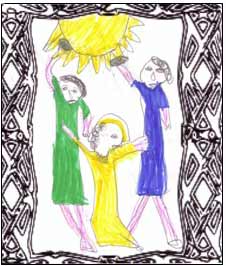Schools
A case study of our work at Christ Church Primary School in Hampstead
If you would like to find out more about researching schools, please follow this link.
Context and background
Christ Church School is a one-form entry voluntary aided school with seven classes (Reception to Year 6) located in Hampstead Village in the London Borough of Camden.
The London Diocesan Board for Schools asked us to be one of the schools involved in the initial stages of the Building on History Project in summer 2009. In autumn 2009 an initial meeting took place between Professor John Wolffe and Dr John Maiden, from the Open University; the head teacher, Katy Forsdyke; and History subject leader, Harriet Chapman; and the priest of Christ Church, Fr Paul Conrad. We identified some interesting aspects of the history of the relationship between the church, school and wider community, and discussed ways in which the children could explore this. Following this Harriet led some training with John Maiden for the teaching staff at Christ Church School to explain the project and enable teachers to share ideas.
At Christ Church School we are fortunate that the parish church, Christ Church, is next to the school, accessed across a pedestrian passageway and open for the school to use at almost any time. We already make use of the space in the Church for class music lessons each week and one-off workshops such as dance workshops, as well as whole school performances and services.
Teaching and learning task for teachers and children
Each class teacher was asked to plan and teach at least one lesson which made use of the church building in order to teach and learn something about the history of the church (or its connection with the school). We also made accessible all the school archives for careful use by teachers and children.
Each class carried out their learning activity, many over a series of lessons spent in the church, over a couple of weeks in Spring 2010. Children recorded their findings in a variety of ways (pictures, writing, tables of data etc) and went on to interpret and respond to what they had found out in several different areas of curriculum (e.g. diary entries in literacy, graphs in maths, maps).
Each class also contributed to a ‘sharing assembly’ later in the term, where they shared their work and what they had discovered with the rest of the school.
 Examples of work
Examples of work
Worksheets are available for each year:
Feedback, responses and next steps
Both teachers and children responded extremely well to the time spent up in the church using the building as a resource for discovering its history. Teachers and children were heard to make comments about the activity being ‘the most interesting thing we’ve done for a while’! The change of scene, the use of relatively familiar building for a different purpose and the interesting and hands-on nature of the learning were all likely to have contributed to these positive responses.
We had the opportunity to share our project and the children’s work with other London history coordinators and representatives from the LDBS at a meeting in Spring 2010.
As a school we have taken a great deal from our participation in the project: pupils and staff have learnt a little more about the Church’s history and its connection with the school; and teachers have learnt about strategies and techniques for using a building as a resource for teaching and learning. We will certainly look differently at our church from now on and have already thought about many ways we can develop this work across all areas of the curriculum.
Katy Forsdyke, 2010






